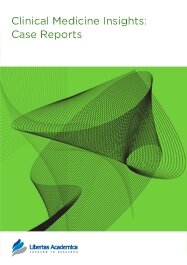

Publication Date: 22 Oct 2009
Type: Case Report
Journal: Clinical Medicine Insights: Case Reports
Citation: Clinical Medicine: Case Reports 2009:2 63-65

We report a case of 30-year-old man presenting chorea in his legs. A brain computed tomography (CT) scan showed bilateral symmetric calcifications in the basal ganglia, thalamus, cerebellum and subcortical white matter. Laboratory studies showed no abnormalities of serum calcium, phosphate, PTH, lactic acid, pyruvic acid and cerebrospinal fluid. Under the diagnosis of Fahr’s disease (FD), we treated with quetiapine (75 mg/day), which completely abolished his symptoms and he showed no other side effect. Our experience suggests that quetiapine is well tolerated in FD patients and effectively treats chorea without extrapyramidal movement.
PDF (1004.67 KB PDF FORMAT)
RIS citation (ENDNOTE, REFERENCE MANAGER, PROCITE, REFWORKS)
BibTex citation (BIBDESK, LATEX)
My experience of publishing my article with Libertas Academia was excellent. They professionally handled the review process. The quality of the reviews were high. I look forward to publishing my scientific papers again with Libertas Academia.

All authors are surveyed after their articles are published. Authors are asked to rate their experience in a variety of areas, and their responses help us to monitor our performance. Presented here are their responses in some key areas. No 'poor' or 'very poor' responses were received; these are represented in the 'other' category.See Our Results
Copyright © 2013 Libertas Academica Ltd (except open access articles and accompanying metadata and supplementary files.)
Facebook Google+ Twitter
Pinterest Tumblr YouTube